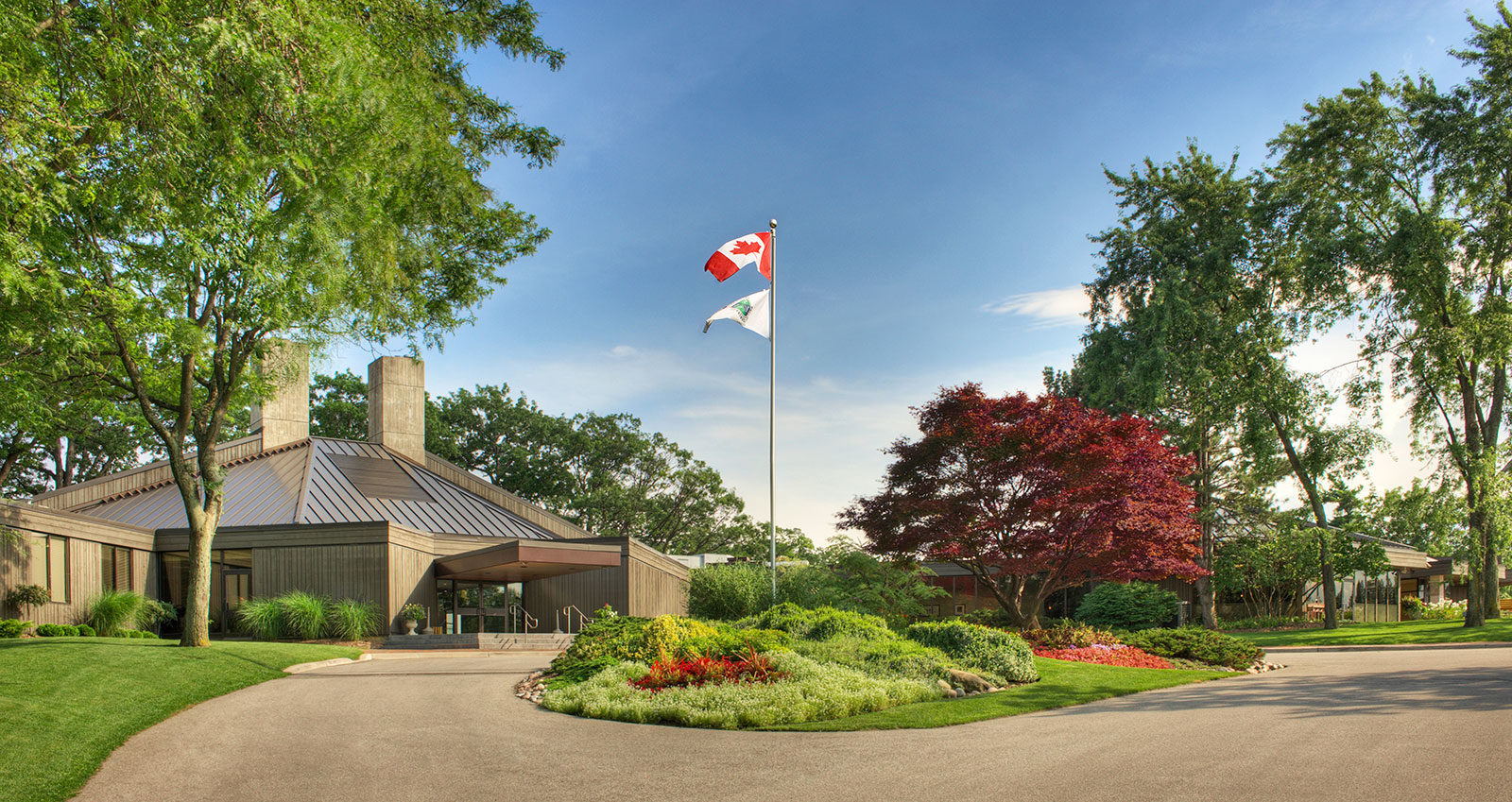Over the past few weeks there have been many good questions about Credit Valley’s tree population and some of our current struggles. Before I go into detail on the particulars, I’d like to take a moment to explain our overall tree management and master plan for the golf course.
In 2015-2016 the current tree inventory and master plan was implemented. Our tree inventory was developed by a certified arborist. Each tree on the property has been physically tagged, GPS logged and evaluated for health. Utilizing GPS we are able to update the inventory in real time as trees are either added or removed.
Within the tree master plan there is a planting plan. The planting plan identifies several planting zones on the property that are suitable for future plantings. These zones are selected very carefully keeping factors in mind such as playability of the golf course, both for today and many years down the road as well as turf health issues that can be brought on by tree shade and finally, keeping in mind future changes to the golf course as per the golf course master plan.
When cataloguing our tree population, one factor evaluated is the risk of susceptibility to disease or insect outbreaks. Areas highlighted for this are concentrated plantings of the same species, which was a very popular practice 40-50 years ago. These areas include(d): the Ash trees between 9/10, which have since been removed and replanted with various species; the Lindens at the south end of the pond; and, the Spruce trees at 8 tees, 12 fairway and between 14/15 fairways. With monocultures (same species) in a tight area, as soon as an insect or disease pressure is introduced we risk losing multiple trees in a very short period of time, which is exactly what we have been experiencing.
Our planting plan takes this into account as we are careful to pick trees that are native to our area and are of a variety of species.
To help better explain our challenges on the golf course, I have provided pictures of the affected trees, what the problem is and our plan moving forward below.
Where and what type of tree?
3 fairway Spruce trees (dogleg)
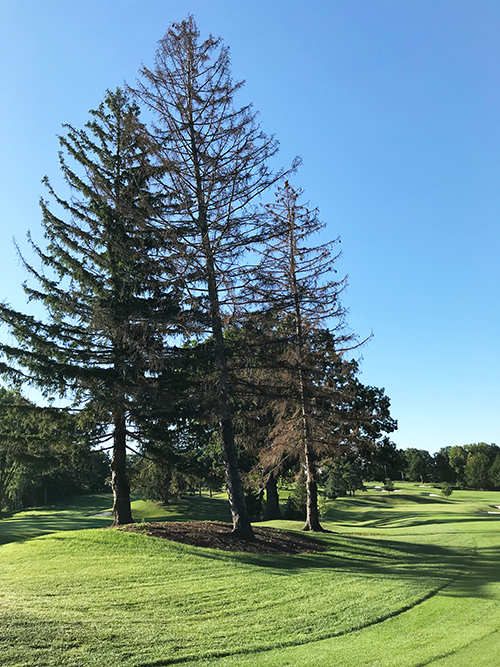
What happened?
At one point, all three of these trees were affected by winter desiccation, a common type of winter injury that occurs when the amount of water lost by the foliage exceeds the amount picked up by the roots. All trees lose water during normal metabolic processes, even in winter. During the growing season when trees are in full foliage, large amounts of water are lost through their leaves. During winter months, photosynthetic processes are slowed, but evergreens continue to lose water at a higher rate than deciduous trees, through their needles. Warm, sunny days or windy conditions increase the amount of water lost from the needles. If the soil is frozen or soil moisture is low due to dry conditions, plant roots are unable to pick up enough water to meet the needs of the tree. As a result, the needles dry out and die. Typically, trees can recover from this if the desiccation isn’t too bad (such as the front tree). Unfortunately, the other two were unable to recover. You may have noticed some small buds on the twigs this spring, but as the tree required more energy to continue the budding process it was still too damaged from the winter to continue.
What is the plan?
These (2) trees will be removed in the fall.
We are working with our arborist and Graham Cooke on some other plantings in the immediate area. Once the planting plans have been developed, they will be on display in the lower level of the clubhouse with the tree master plan as well as on the website.
Where and what type of tree?
Vines and Spruce trees along 5 tee fence
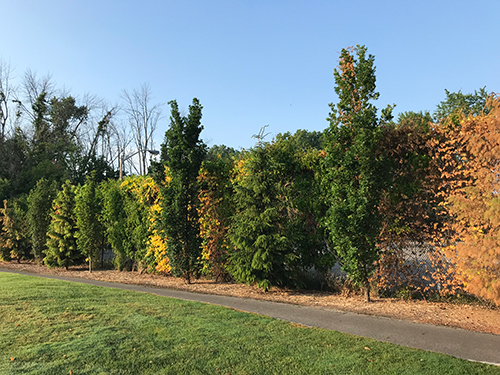
What happened?
Due to exposure in this area, desiccation affected these trees and the vines as well. The extreme heat and drought this season has made it nearly impossible for recovery. To help, we have been supplementing water to the area as often as possible.
What is the plan?
At this point, we will do our best with supplemental water and wait and see how the rest of the summer goes. I expect that we will be planting several fast-growing vines in the fall to help fill the gaps as soon as possible.
Where and what type of tree?
Oak tree to the right of 4 tee
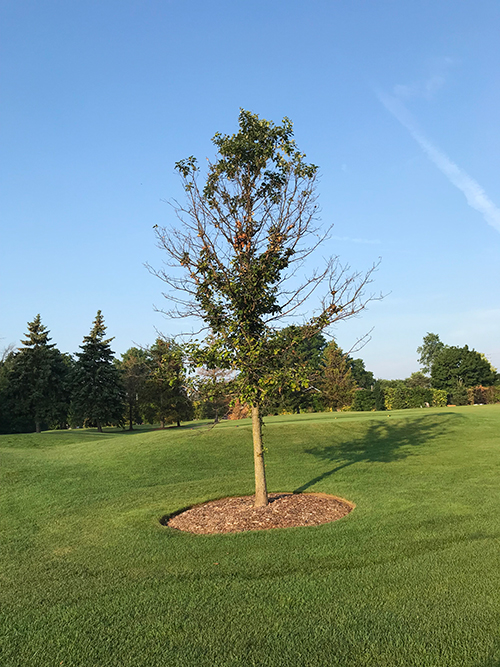
What happened?
Our irrigation water contains high levels of salt and bicarbonates. Unfortunately, there is very little we can do about this as salt applied to parking lots, roads and driveways ultimately finds it’s way into the river during rain and snow melt. During periods of heat and drought this water can become phytotoxic to the leaves, actually burning them. This same risk exists for turf; however, we have tools at our disposal to buffer this condition.
What is the plan?
Despite its appearance, the tree is still actively growing. Any breaks in heat and drought will help the tree significantly.
Where and what type of tree?
Spruce trees 8 tee/17 fairway, 12 fairway and 14/15 fairway
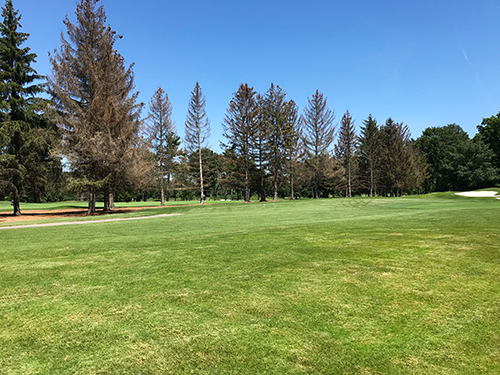
What happened?
During the cool, wet spring and summer last year a fungus known as Cytospora became active in select trees. Unfortunately, this disease is very difficult to treat as it can easily jump from tree to tree killing the branches it comes in contact with.
What is the plan?
This disease was diagnosed within weeks of the first symptoms. We began treatment immediately with limited success. The extreme heat and drought this summer has further stressed the remaining infected population resulting in the loss of most trees.
We have met with our arborist and Graham Cooke to evaluate the area and to begin to devise a future planting plan. Once the planting plans have been developed, they will be on display in the lower level of the clubhouse with the tree master plan as well as on the website.
Where and what type of tree?
Linden tree, 18 fairway
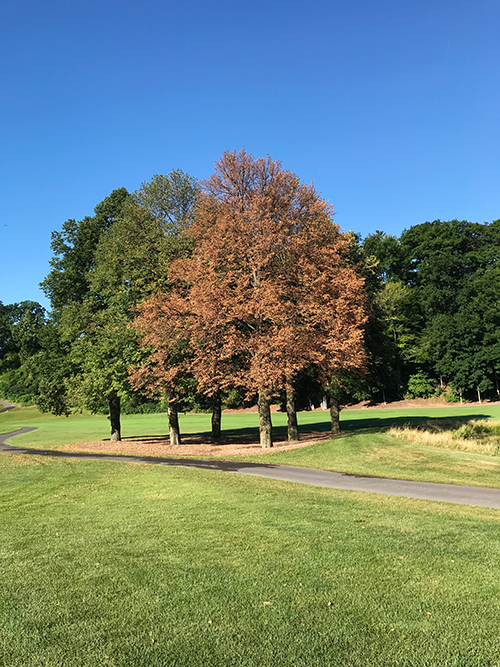
What happened?
A Phytophthora root dysfunction has essentially cut off the flow of water and nutrients from the ground to the tree. Similar to the Spruce trees, in a monoculture such as this the disease can spread quickly. The recent extreme heat and drought has exacerbated the disease.
What is the plan?
Luckily, we were able to diagnose the disease within a couple of days of the symptoms being present. We have since treated the trees in the area and are optimistic that we have limited the loss to only a couple of trees.
The last few years have undoubtedly been difficult on our tree population. Although it appears that the glass is half empty right now we have a solid management plan in place to address our current struggles as well as a long-term plan that should help foster a tree population at Credit Valley that will be enjoyed by members and guests for many years to come.

